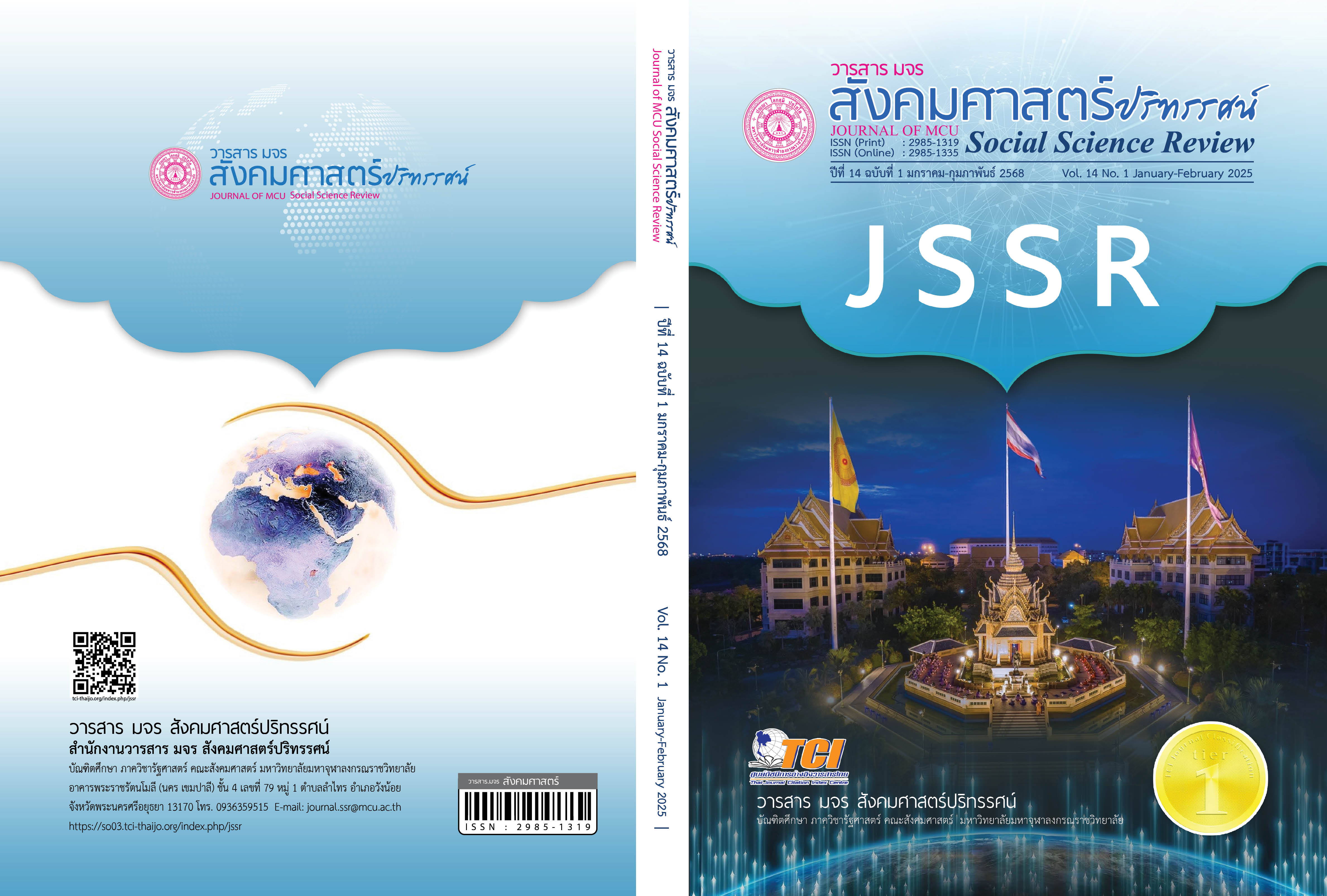แนวทางการจัดตั้งสำนักจัดการทรัพย์สินพระพุทธศาสนาในประเทศไทย
คำสำคัญ:
สำนักจัดการทรัพย์สินพระพุทธศาสนา, งานสาธารณูปการ, คณะสงฆ์ไทยบทคัดย่อ
บทความวิจัยครั้งนี้มีวัตถุประสงค์ 1. ศึกษาหลักการและวิธีการจัดการทรัพย์สินของวัด 2. พัฒนาต้นแบบสำนักจัดการทรัพย์สินพระพุทธศาสนา และ 3. จัดทำข้อเสนอแนะเชิงนโยบาย โดยใช้ระเบียบวิธีวิจัยแบบวิจัยและพัฒนา ประกอบด้วย 7 ขั้นตอน เริ่มจากการศึกษาเอกสารและสัมภาษณ์เชิงลึกผู้เชี่ยวชาญ การสำรวจความคิดเห็นพระสงฆ์และประชาชน 500 คน การพัฒนาแนวทางและต้นแบบผ่านการสนทนากลุ่มและทดลองใช้ในวัดนำร่อง และการจัดทำข้อเสนอแนะเชิงนโยบาย
ผลการวิจัยพบว่า 1. หลักการจัดการทรัพย์สินของวัดควรบูรณาการหลักพุทธธรรม หลักกฎหมาย และหลักการบริหารจัดการสมัยใหม่ โดยมีวิธีการจัดการ 4 ด้าน ได้แก่ การจัดการการเงินและบัญชี การจัดการที่ดินและสิ่งปลูกสร้าง การจัดการศาสนสมบัติ และการจัดการรายได้และผลประโยชน์ 2. การพัฒนาต้นแบบสำนักจัดการทรัพย์สินพระพุทธศาสนาเสนอให้จัดตั้งเป็นหน่วยงานระดับจังหวัด ภายใต้การกำกับดูแลของสำนักงานเจ้าคณะจังหวัด โดยมีการแบ่งส่วนงานภายในเป็น 4 ฝ่ายหลัก 3. ข้อเสนอแนะเชิงนโยบายแบ่งเป็น 3 ด้าน ได้แก่ นโยบายต่อคณะสงฆ์ที่เน้นการปรับปรุงโครงสร้างการบริหารและธรรมาภิบาล นโยบายต่อภาครัฐที่เน้นการปรับปรุงกฎหมายและการสนับสนุนด้านวิชาการ และนโยบายต่อภาคประชาชนที่เน้นการส่งเสริมการมีส่วนร่วมและการตรวจสอบอย่างสร้างสรรค์ ทั้งนี้ การนำไปปฏิบัติควรดำเนินการอย่างเป็นระบบและปรับใช้ให้เหมาะสมกับบริบทของแต่ละพื้นที่
เอกสารอ้างอิง
กฎกระทรวงฉบับที่ 2 (พ.ศ. 2511) ออกตามความในพระราชบัญญัติคณะสงฆ์ พ.ศ. 2505. (2511, 10 ตุลาคม). ราชกิจจานุเบกษา. เล่ม 85 ตอนที่ 92 หน้า 735-744.
กนก แสนประเสริฐ และคณะ. (2545). การจัดการดูแลทรัพย์สินและศาสนสมบัติของวัด (รายงานการวิจัย). กรุงเทพฯ: สถาบันบัณฑิตพัฒนบริหารศาสตร์.
กรมการศาสนา กระทรวงวัฒนธรรม. (2557). คู่มือการดูแลและจัดการศาสนสมบัติ. กรุงเทพฯ: โรงพิมพ์ชุมนุมสหกรณ์การเกษตรแห่งประเทศไทย.
กรมศิลปากร. (2539). กฎหมายตราสามดวง. กรุงเทพฯ: กรมศิลปากร.
จันจิรา อ่อนฉ่ำ. (2565). นายทุนฮุบที่วัด 12 แปลง ชาวบ้านเขาค้อรุกที่ปลูกผัก. สืบค้น 2 กุมภาพันธ์ 2566, จาก https://shorturl.asia/4KG7H
ณดา จันทร์สม และคณะ. (2556). รูปแบบการจัดการปัญหาการบุกรุกที่ดินของวัด. วารสารศิลปากรศึกษาศาสตร์วิจัย, 5(2), 334-335.
ณดา จันทร์สม. (2555). การบริหารการเงินของวัดในประเทศไทย (รายงานการวิจัย). กรุงเทพฯ: สถาบันบัณฑิตพัฒนบริหารศาสตร์.
นักวิชาการด้านพระพุทธศาสนาท่านหนึ่ง. (2567, 25 มกราคม). [บทสัมภาษณ์].
ผู้บริหารสำนักงานพระพุทธศาสนาแห่งชาติท่านหนึ่ง. (2567, 22 มกราคม). [บทสัมภาษณ์].
พระธรรมปิฎก (ป.อ. ปยุตฺโต). (2546). พจนานุกรมพุทธศาสตร์ ฉบับประมวลธรรม. กรุงเทพฯ: โรงพิมพ์มหาจุฬาลงกรณราชวิทยาลัย.
พระพรหมคุณาภรณ์ (ป.อ. ปยุตฺโต). (2550). ธรรมนูญชีวิต. กรุงเทพฯ: โรงพิมพ์การศาสนา.
_____. (2555). พุทธธรรม ฉบับปรับขยาย. กรุงเทพฯ: โรงพิมพ์มหาจุฬาลงกรณราชวิทยาลัย.
พระมหาธฤติ วิโรจโน. (2557). รูปแบบการพัฒนาพระสังฆาธิการเพื่อประสิทธิภาพการบริหารกิจการคณะสงฆ์. วารสารบัณฑิตศึกษา มนุษยศาสตร์ สังคมศาสตร์, 3(1), 65-88.
พระมหาสุทิตย์ อาภากโร และคณะ. (2556). การพัฒนาระบบการบริหารจัดการและการสร้างเครือข่ายองค์กรพระพุทธศาสนาในประเทศไทย (รายงานการวิจัย). กรุงเทพฯ: สำนักงานกองทุนสนับสนุนการวิจัย.
พระมหาสุนันท์ สุนนฺโท. (2557). การพัฒนารูปแบบการจัดการศาสนสมบัติของวัดในจังหวัดพระนครศรีอยุธยา (ดุษฎีนิพนธ์พุทธศาสตรดุษฎีบัณฑิต สาขาวิชาการเชิงพุทธ). พระนครศรีอยุธยา: มหาวิทยาลัยมหาจุฬาลงกรณราชวิทยาลัย.
พระมหาสุระ ญาณธโร และคณะ. (2560). การทุจริตการเงินของวัดในจังหวัดนครปฐม. วารสารสมาคมนักวิจัย, 22(2), 124-125.
พระราชบัญญัติคณะสงฆ์ พ.ศ. 2505. (2505, 31 ธันวาคม). ราชกิจจานุเบกษา. เล่ม 79 ตอนที่ 115 (ฉบับพิเศษ) หน้า 29-45.
พระสังฆาธิการรูปหนึ่ง. (2567, 10 มกราคม). [บทสัมภาษณ์].
พระอำนวย หมอกเมฆ. (2553). กลยุทธ์การบริหารวัดในพระพุทธศาสนาสำหรับเจ้าอาวาสวัดราษฎร์ในเขตหนเหนือ ภาค 4. วารสารมนุษยศาสตร์และสังคมศาสตร์ มหาวิทยาลัย ราชภัฏกำแพงเพชร, 19(1), 79-90.
พีรณัฏฐ์ ยาทิพย์ และกรรณิการ์ จะกอ. (2554). การจัดทำบัญชีของพระอารามหลวงในเขตพื้นที่ปริมณฑลของกรุงเทพมหานคร (รายงานการวิจัย). นนทบุรี: วิทยาลัยราชพฤกษ์.
สมเด็จฯ กรมพระยาดำรงราชานุภาพ. (2514). ตำนานพระพุทธเจดีย์สยาม. กรุงเทพฯ: กรมศิลปากร.
สำนักงานพระพุทธศาสนาแห่งชาติ. (2560). แนวทางการจัดการศาสนสมบัติ. กรุงเทพฯ: โรงพิมพ์สำนักงานพระพุทธศาสนาแห่งชาติ.
Committee of Sponsoring Organizations of the Treadway Commission. (2004). Enterprise risk management: Integrated framework: Executive summary. US: COSO.
Gulick, L. & Urwick, L. (1973). Papers on the science of administration. Ireland: Institute of Public Administration.
Mintzberg, H. (1994). The rise and fall of strategic planning. New York: Free Press.
ดาวน์โหลด
เผยแพร่แล้ว
รูปแบบการอ้างอิง
ฉบับ
ประเภทบทความ
สัญญาอนุญาต
ลิขสิทธิ์ (c) 2024 วารสาร มจร สังคมศาสตร์ปริทรรศน์

อนุญาตภายใต้เงื่อนไข Creative Commons Attribution-NonCommercial-NoDerivatives 4.0 International License.
เพื่อให้เป็นไปตามกฎหมายลิขสิทธิ์ ผู้นิพนธ์ทุกท่านต้องลงลายมือชื่อในแบบฟอร์มใบมอบลิขสิทธิ์บทความให้แก่วารสารฯ พร้อมกับบทความต้นฉบับที่ได้แก้ไขครั้งสุดท้าย นอกจากนี้ ผู้นิพนธ์ทุกท่านต้องยืนยันว่าบทความต้นฉบับที่ส่งมาตีพิมพ์นั้น ได้ส่งมาตีพิมพ์เฉพาะในวารสาร มจร สังคมศาสตร์ปริทรรศน์ เพียงแห่งเดียวเท่านั้น หากมีการใช้ภาพหรือตารางหรือเนื้อหาอื่นๆ ของผู้นิพนธ์อื่นที่ปรากฏในสิ่งตีพิมพ์อื่นมาแล้ว ผู้นิพนธ์ต้องขออนุญาตเจ้าของลิขสิทธิ์ก่อน พร้อมทั้งแสดงหนังสือที่ได้รับการยินยอมต่อบรรณาธิการ ก่อนที่บทความจะได้รับการตีพิมพ์ หากไม่เป็นไปตามข้อกำหนดเบื้องต้น ทางวารสารจะถอดบทความของท่านออกโดยไม่มีข้อยกเว้นใดๆ ทั้งสิ้น





